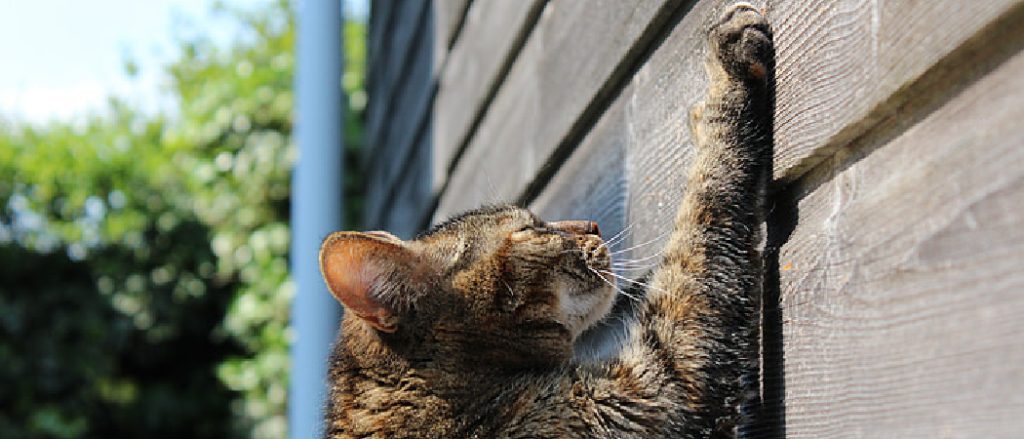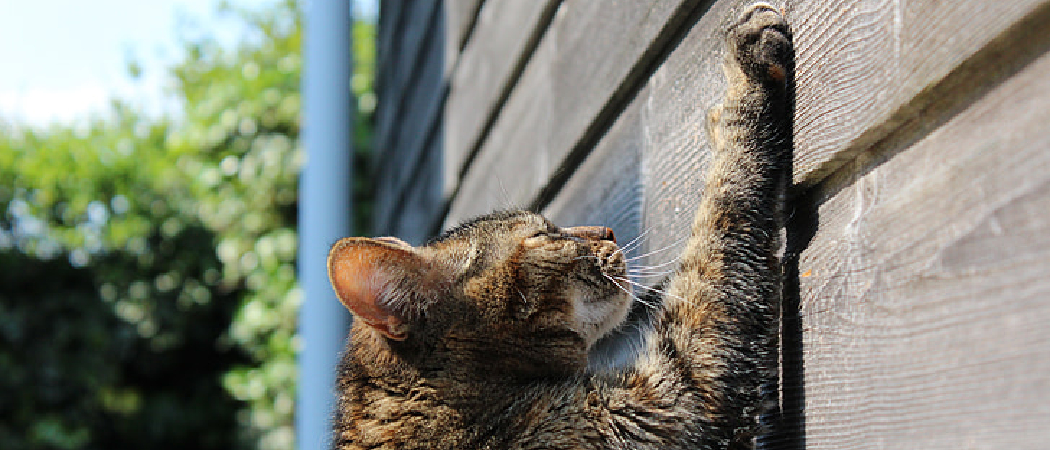Cats scratch the walls due to instinctive behavior and need to mark territory or remove old claw sheaths. Cats scratch to mark their territory or remove old claw sheaths.

In addition to scratching the walls, cats may also scratch furniture or other objects in the home. However, as a cat owner, there are steps you can take to redirect this behavior and protect your walls and furniture. Understanding why cats scratch and providing appropriate outlets for this behavior can help alleviate the issue and create a happy and harmonious home environment for both you and your feline companion.

Credit: www.synthesia.io
Understanding The Behavior Of Cats
Understanding the behavior of cats is crucial for cat owners to ensure their pets are happy and healthy. One common behavior that might puzzle cat owners is scratching the walls. This behavior can be frustrating and destructive, but it has underlying reasons that can be addressed. In this article, we will delve into the nature of cats and explore the reasons behind their scratching behavior.
The Nature Of Cats
Cats have an innate need to scratch. It’s a natural instinct that serves multiple purposes for them. Scratching helps cats shed the outer layer of their claws, keeping them sharp and healthy. It also allows them to stretch their muscles and relieve stress. Furthermore, scratching serves as a way for cats to mark their territory. When a cat scratches, it leaves both a visual mark and a scent from glands in its paws.
Reasons For Scratching Behavior
1. Maintenance of Claws: Cats have retractable claws, and scratching is a way for them to maintain them. By scratching, cats remove the dead outer layer of their claws, exposing the sharp new layer underneath. This helps them in climbing, hunting, and self-defense.
2. Muscle Stretching: Scratching allows cats to stretch their muscles, particularly in their legs and back. Similar to how humans stretch in the morning to alleviate stiffness, cats use scratching as a natural way to loosen up and keep their bodies limber.
3. Territorial Marking: Cats have scent glands located in their paw pads, and when they scratch, they leave their scent on the scratched surface. This scent acts as a mark that signals to other cats that the territory has been claimed. It’s their way of communicating and asserting their dominance in their territory.
4. Emotional Release: Scratching can also serve as a way for cats to release pent-up emotions or stress. It provides them with an outlet for their energy and can provide a sense of comfort and security.
5. Boredom and Lack of Stimulation: Cats are intelligent and active animals, and if they don’t have enough mental and physical stimulation, they may resort to excessive scratching as a way to alleviate boredom or frustration.
Now that you understand the nature of cats and the reasons behind their scratching behavior, you can take steps to address this behavior and provide your cat with appropriate alternatives. By providing scratching posts or boards, regularly trimming your cat’s nails, and ensuring they have enough playtime and mental stimulation, you can redirect their scratching behavior and preserve your walls from further damage.
:strip_icc()/best-cat-trees-4159408-da66af890782426fb82e6036af07b36b.jpg)
Credit: www.thesprucepets.com
Psychological Needs Of Cats
Understanding the psychological needs of cats is key to addressing their behaviors and providing them with a fulfilling environment. Scratching is a natural instinct in cats, serving multiple purposes in their lives. When your furry friend scratches the walls, it could be a sign that their psychological needs are not being met. In this article, we will explore two important psychological needs of cats that can contribute to wall scratching: territory marking and relieving stress and anxiety.
Territory Marking And Scratching
One of the primary reasons why cats scratch the walls is to mark their territory. Cats have scent glands in their paw pads that secrete pheromones when they scratch a surface. This activity allows them to not only stretch their muscles but also leave a visual and olfactory mark of ownership. By scratching the walls, your cat is asserting their presence and creating a sense of comfort and security in their environment.
It’s important to note that scratching is not a destructive behavior, but rather a natural instinct. To redirect this behavior away from your walls, providing your cat with appropriate scratching options is crucial. Consider purchasing a scratching post or a cat tree, as these serve as alternative surfaces for your cat to scratch and mark their territory.
Relieving Stress And Anxiety
Cats are sensitive beings, and any changes in their surroundings can cause stress and anxiety. When cats feel overwhelmed or anxious, they may resort to scratching the walls as a way to cope with their emotions. Scratching functions as a stress reliever, allowing them to release pent-up energy and anxiety.
Identifying the root cause of stress or anxiety in your cat’s environment is crucial. It could be triggered by a new pet, changes in routine, the presence of strays outside the window, or even a lack of vertical space for them to feel safe. By pinpointing the underlying cause, you can take appropriate steps to alleviate your cat’s stress, which may result in a decrease in wall scratching behavior.
Some effective strategies to help reduce stress and anxiety in cats include:
- Ensuring a daily routine and consistency in their environment
- Providing them with plenty of opportunities for mental stimulation and playtime
- Creating a safe and secure space, such as high perches or hiding spots
- Using pheromone diffusers or calming products recommended by your veterinarian
Remember, patience and understanding are key when addressing your cat’s psychological needs. By providing appropriate scratching surfaces and addressing any underlying stress or anxiety, you can help redirect their behavior away from the walls and towards more suitable options, creating a harmonious living environment for both you and your feline companion.
Addressing And Preventing Wall Scratching
Providing Appropriate Scratching Surfaces
One effective way to address and prevent wall scratching in cats is by providing them with appropriate scratching surfaces. Cats have a natural instinct to scratch, which helps them maintain healthy claws and stretch their muscles. By offering them suitable alternatives to the walls, you can redirect their scratching behavior.
Choose scratching surfaces that mimic the texture your cat enjoys scratching on the walls. This could include sisal rope, corrugated cardboard, or carpeted scratching posts. Place these surfaces strategically near the areas where your cat tends to scratch the walls the most. By providing a desirable alternative, you’ll encourage your cat to use the appropriate surfaces instead of the walls.
Redirecting And Distracting Behaviors
If you catch your cat in the act of wall scratching, it’s important to redirect their behavior immediately. Clapping your hands sharply or using a noise deterrent like a can filled with coins can startle your cat and stop them from continuing the undesirable behavior. However, it’s vital to remain calm and avoid scolding or punishing your cat, as this can create fear and anxiety.
In addition to redirecting, it’s crucial to provide sufficient mental and physical stimulation for your cat. Boredom and pent-up energy can contribute to wall scratching. Engage your furry friend in regular play sessions using toys that mimic prey, such as feather wands or laser pointers. Puzzle toys and interactive feeders can also help keep their minds engaged and alleviate boredom.
Seeking Professional Help
If despite your efforts, your cat continues to scratch the walls persistently, it may be time to seek professional help. Consulting with a veterinarian or a feline behaviorist can provide valuable insights into the underlying reasons for your cat’s behavior. They can evaluate your cat’s environment, health, and overall well-being to determine any potential causes of wall scratching.
A professional can also suggest additional measures, such as using pheromone sprays or diffusers to create a calming atmosphere for your cat. They may recommend behavior modification techniques, such as positive reinforcement training, to help redirect your cat’s scratching behavior effectively. Remember, every cat is unique, and finding the right approach may require a tailored solution.

Credit: www.amazon.com
Frequently Asked Questions For Why Does My Cat Scratch The Walls
What Does It Mean When Your Cat Scratches The Wall?
Cats scratch walls to mark territory, relieve stress, or sharpen their claws. Providing scratching posts and toys can redirect this behavior.
How Do I Stop My Cat From Scratching The Wall?
To stop your cat from scratching the wall: 1. Provide alternative scratching options like scratching posts or pads. 2. Use deterrents like double-sided tape or aluminum foil on the walls. 3. Keep your cat’s nails trimmed to minimize damage. 4. Consider using pheromone sprays to discourage scratching behavior.
5. Give your cat plenty of exercise and mental stimulation to reduce the desire to scratch.
Why Does My Cat Scratch The Wall When Using The Litterbox?
Cats may scratch the wall while using the litterbox due to territorial marking or discomfort. It’s normal behavior for them to scratch and cover their waste. To prevent this, provide a sturdy litterbox, choose the right litter, and make sure the box is clean.
Why Does My Cat Keep Scratching The Wall Instead Of A Scratching Post?
Cats may scratch the wall instead of a scratching post due to several reasons, like the texture or height of the wall. Provide a variety of scratching options, including different textures and heights, to encourage using the scratching post.
Conclusion
To summarize, understanding why your cat scratches the walls is key to addressing this behavior. By recognizing the underlying causes, such as territorial marking or boredom, you can take appropriate measures to redirect their scratching to more appropriate surfaces. Providing scratching posts, engaging toys, and environmental enrichment can go a long way in preventing wall scratching and promoting your cat’s overall well-being.
Remember, a happy and stimulated cat is less likely to exhibit destructive behavior.


